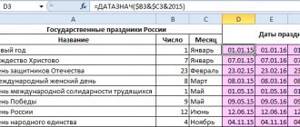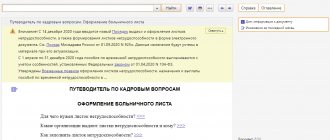How to calculate the average daily earnings for a month according to the minimum wage when an employee is dismissed. Based on the average daily earnings, the basic payments for severance pay that are due to the employee are calculated. These payments include travel allowances, vacation pay and other payments.
According to Art. 139 of the Labor Code of the Russian Federation establishes that the general procedure for calculating average earnings involves all types of payments provided for by the labor protection system. Moreover, the source of their origin does not matter.
Let's consider the main aspects of calculating average daily earnings, as well as average earnings for various cases.
When is it necessary to calculate average earnings?
The law establishes dozens of situations when an employee must be paid a salary based on average earnings. But all of them can be divided into two groups:
- "Labor" payments.
We are talking about situations where the calculation of average earnings is provided for by the Labor Code. Most often, this need arises when calculating vacation pay or sending an employee on a business trip. But the Labor Code of the Russian Federation also provides for many other situations when an employee has the right to be paid according to average earnings. This is, for example, a period of training while away from work, forced downtime, etc.
- "Social payments.
Payments for unworked time are provided for not only by labor legislation, but also by social legislation. In this case we are talking about sick leave and maternity benefits.
Let us consider in detail the procedure for calculating average earnings in all these situations.
How to determine the period for calculation
There are many nuances when identifying a billing period. There are specific features when calculating average labor remuneration for different cases.
Important!
Full calendar months are always taken into account. For example, the time period from August 15 to September 14 is not a calendar month. But the period from September 1 to September 30 is already a suitable period of time for determining average earnings.
There is another point that often raises questions: which months should we take into the billing period? It is best to consider the situation with examples.
Let's assume a person quits on August 1, 2021. Then the period considered as the settlement period will include 12 months up to July 2018 inclusive. The same time period is taken into account if the employee terminates the contract, say, 08/25/2021. But dismissal on the final day of the geographic month (08/31/2021) already shifts the period for calculation; it will then include August 2021.
True, there is a nuance here too. It happens that the last day of work is, for example, August 29. This is followed by two days off – August 30 and 31. That is, a person actually leaves on the last working day (according to the production calendar), but not on the last calendar day. Then the final month of the billing period will be July, not August.
Excluded periods
The calculation usually does not include time periods during which the employee was supposed to be present at the workplace, but for various reasons could not do so.
Periods that are not excluded
The periods of time used by employees to feed their children are taken into account when calculating the average labor remuneration. The calculation also includes periods of employee absence from work due to his own fault: absenteeism, strikes, downtime, etc.
Atypical cases
Of particular interest are the so-called atypical cases that accounting workers sometimes encounter when determining the average labor remuneration.
No actual amounts worked
It happens that it is necessary to calculate the amount of payment, determined by average earnings, for a new employee. For example, a person has just got a job at an enterprise, and he is immediately sent on a business trip. But he has no accruals yet, so it is not possible to calculate the average labor remuneration. In such cases, all payments are made based on the established salary.
No salary for the pay period
If the employee does not have accruals for the period that is the calculation period, the determination of the average labor remuneration is carried out according to the data of the previous time period.
Not worked 12 months
In such a situation we are talking about an incomplete period. It will begin with the month in which the employment relationship began, and end, as a general rule, with a fully worked calendar month preceding the month of severance of the employment relationship.
General rules for calculating “labor” average earnings
The procedure for determining average earnings in all cases determined by the Labor Code of the Russian Federation is established by Decree of the Government of the Russian Federation dated December 24, 2007 No. 922.
The basic rules here are as follows:
- Average earnings are calculated for the last 12 months
- All payments related to work activity are taken into account: salary (tariff), allowances, bonuses, etc.
- Payments for unworked periods (vacation pay, sick leave, etc.) are not included in the calculation.
- If an employee works full time or fulfills production standards, his average earnings cannot be lower than those calculated on the basis of the minimum wage.
The inclusion of bonus payments in average earnings is associated with a number of features (clause 15 of Resolution No. 922):
- Monthly bonuses are generally included in the same way as salaries. But if they are accrued on different bases, then no more than one bonus per month is taken for each indicator.
- Quarterly and semi-annual bonuses, if the accrual period is fully included in the calculation period, are taken in full. If the bonus period and the billing year “overlap” partially, then part of the bonus is used for calculation, which corresponds to the number of “coinciding” months.
- Annual bonuses, long service awards, etc. are taken into account in full if they relate to the year preceding the “average” payment.
A situation may arise where in the previous 12 months the employee did not have income on which to base the calculation. Then use the following options (clauses 6-8 of resolution No. 922):
- Income is taken for the 12 months preceding the billing period.
- If there was no income before the beginning of the current month, then data for this month is used.
- If the salary has not yet been accrued at all, then the calculation is made on the basis of the tariff (salary).
If the organization has experienced an increase in wages, and the billing period “covers” a time with a lower wage level, then it may turn out that payments based on average earnings will be lower than for other employees. To avoid such a situation, the calculated amount must be increased by a factor equal to the ratio of the “new” and “old” salary (clause 16 of Resolution No. 922).
An example of calculating average daily earnings for vacation
Arina goes on vacation on July 31, 2021. Her salary has not changed for more than a year and is 30 thousand rubles. I didn’t take sick leave, I didn’t go on business trips. Over the past 12 months, I have been on vacation once, from November 1 to November 14, 2021.
- The billing period is from July 1, 2021 to June 30, 2021. We exclude from it 14 days spent on vacation.
- Earnings for the billing period - 345 thousand rubles (11 x 30,000 + 15,000).
- The number of days worked during the billing period is 337.9 (11 x 29.3 + 16 / 30 x 29.3).
- Average daily earnings = 345 thousand rubles / 337.9 = 1021.01 rubles.
To avoid manual calculations, use a vacation pay calculator.
We wrote about how to book a vacation in the article.
The procedure for calculating “labor” average earnings
The method for calculating average earnings depends on the purpose for which the size of the payment is determined
- Vacation pay calculation
In this case, the average daily earnings (ADE) are determined based on the “conditional” number of calendar days in a month – 29.3.
In the simplest situation, when all 12 months of the billing period are worked out without gaps:
SDZ = FOT / (12 x 29.3)
Payroll - all payments included in the calculation.
But, of course, this is not always the case. An employee could work for less than a year, take sick leave, etc. Then the formula takes the following form
SDZ = payroll (KPM x 29.3 + DNP)
KPM - number of months worked in full
DNP - calendar days falling on time worked in “incomplete” months
DNP = 29.3 / KD x KDR
CD – the total number of calendar days in an “incomplete” month
KDR - the number of calendar days falling on the worked period
- Calculation of average earnings in other cases provided for by the Labor Code of the Russian Federation
If the calculation of average earnings is not related to vacation pay (for example, an employee goes on a business trip), then the formula will be simpler:
SZ = FOT / KD (CC)
KD (KCH) is the number of days (or hours - with hourly accounting) actually worked during the reporting period.
Next, you need to multiply the average earnings by the number of days to be paid. For vacations these will be calendar days, in other cases - working days.
B = SDZ x D
Unemployment benefit
The procedure for assigning this benefit is regulated by the law of April 19, 1991 No. 1032-1 “On Employment”.
A citizen who is recognized as unemployed and has worked for at least 26 weeks in the previous year, within 12 months after registration, receives a benefit in the amount of 75% to 45% of average earnings, but not higher than the established maximum amount (the percentage gradually decreases). If during this time he does not find a job, then for another 12 months he will receive benefits in the minimum amount.
If a citizen is looking for work for the first time, has insufficient work experience or was fired for violations of labor discipline, then he is paid a minimum benefit for 12 months
The minimum and maximum benefit amount for 2021 is established by Decree of the Government of the Russian Federation dated November 24, 2017 N 1423 in the amount of 850.00 rubles . and 4900.00 rub . respectively. These amounts are in no way tied to the minimum wage and will not change until the end of 2021.
Currently, the Ministry of Labor is developing a bill, in particular, providing for an increase in the amount of unemployment benefits to the subsistence level. The minimum wage, starting with the May increase, will also be tied to this indicator. Therefore, if the project proposed by the Ministry of Labor is adopted, a relationship will arise between the minimum wage and the amount of unemployment benefits. But in any case, this will not happen until 2021.
Example 1
Manager Ivanov A.V. goes on vacation for two weeks from January 14, 2019. In 2021, he was on sick leave from October 1 to October 14. The employee's total income for 2021 (excluding sick leave) amounted to 580 thousand rubles.
First, we determine the number of days that need to be taken into account for an “incomplete” month, i.e. for October.
DNP = 29.3 / 31 x (31-14) = 16
Now let's calculate the total number of days per year that need to be included in the calculation:
CD = 29.3 x 11 + 16 = 338.3
Hence,
SDZ = 580,000 / 338.3 = 1714.45 rubles.
Amount of vacation pay for 14 calendar days
O = 14 x 1714.45 = 24,002.36 rubles.
An example of calculating average daily earnings for business travelers
Valentin is leaving on a business trip on August 23, 2021. His salary has not changed for more than a year and is 45 thousand rubles. Over the past 12 months, I have not been on vacation, sick leave or on a business trip.
- The billing period is from August 1, 2021 to July 31, 2020.
- Earnings for the billing period are 540 thousand rubles (12 * 45,000).
- The number of days actually worked during the billing period is 247.
- Average daily earnings = 540 thousand rubles / 247 = 2186.23 rubles.
We wrote about how to arrange a business trip in the article.
Example 2
Now suppose that Ivanov A.V. sent on a two-week business trip from January 14, 2019. In this case, we need to determine the number of days worked by him in the billing period. The total number of working days in 2021 according to the five-day calendar is 247. Sick leave from October 1 to October 14 accounts for 10 working days. Hence:
SDZ = 580,000 / (247 - 10) = 2,447.26 rubles.
A business trip from January 14 to January 27, 2021 requires 10 working days. Therefore, Ivanov will be accrued for this time
Z = 2,447.26 x 10 = 24,472.6 rubles.
As the examples show, despite different calculation methods, the amount of payments differs slightly (the difference is less than 2%).
Thus, regardless of the reason why an employee is transferred to “average” pay, he can count on comparable remuneration.
SDZ for a business trip
Step 1: Determine the billing period
The billing period is 12 months before the business trip.
Lyudmila went on a business trip on June 15, 2021, the billing period is from June 1, 2021 to May 31, 2021.
If the employee has worked for less than a year, take the period from the date of hire to the last day of the month before the vacation to calculate.
Maxim joined the company on January 15, and on July 8 he was sent on a business trip. This means that the billing period is from January 15 to June 31.
Step 2: calculate your earnings for the pay period
Take into account the salary with all allowances and coefficients, bonuses - according to the rules from paragraph 15 of the Government Decree.
Do not take into account sick leave and benefits, vacation pay, payments based on average earnings and other accruals from paragraph 5 of the Government Decree.
Step 3: count the number of days actually worked during the billing period
Look at the number of working days on the timesheet. Add up the actual days worked in each month, and you will get the number of days worked for the billing period.
Step 4: Calculate your average daily earnings using the formula
SDZ = Earnings for the billing period / days worked for the billing period
Calculation of average earnings for social benefits
Average wages are calculated not only on the basis of labor legislation, but also on the basis of social legislation. When calculating sick leave and maternity benefits, the main regulatory documents are:
- Law of December 29, 2006 No. 255-FZ.
- Decree of the Government of the Russian Federation dated June 15, 2007 No. 375.
The basic rules here are as follows:
- The settlement period is two calendar years preceding the year in which the payment was accrued.
- All payments subject to contributions to the Social Insurance Fund are taken into account.
- It is necessary to comply with limits limiting the amount of payments both “above” and “below”. The maximum amounts of social payments are approved by the Government, the minimum amounts are determined on the basis of the minimum wage.
The procedure for determining average daily earnings depends on the type of social benefit:
- For sick leave, the amount of income for two years is divided by 730.
- For maternity payments, two-year income is divided by the number of calendar days for two years, minus the periods:
— maternity leave;
— temporary disability;
— exemption from work for other reasons, if payments during this time were not subject to contributions to the Social Insurance Fund.
If the employee had no income during the billing period, or if maternity leave occurred during this period, then the two years preceding the billing period can be used. In this case, the payment amount should increase (clause 11 of Resolution No. 375).
If the employee did not have income for the previous 4 years, or if his average monthly income was lower than the current minimum wage, then the minimum wage multiplied by 24 should be used as the calculated amount.
All bonuses accrued in the billing period are used to calculate average earnings, even if the bonus period extends beyond the billing months. The main thing is that the premium amount is subject to contributions to the Social Insurance Fund (clause 14 of Resolution No. 375). Therefore, if an employee receives large bonuses, then it may be “more profitable” for him to be sick than to go on vacation.
But with salary increases the situation is the opposite. To calculate social benefits, a higher level of remuneration is taken into account only from the date of its actual increase. No recalculation is made here, as when calculating vacation pay (clause 12 of Resolution No. 375).
Average earnings for the Employment Center (for the last 3 months)
The average income for the central labor protection center is usually calculated in order to determine the amount of benefits for people who are unemployed. Three months preceding the date of dismissal are taken into account.
The calculation itself is carried out in several steps.
- The period is determined - 3 months fully worked before the termination of the employment relationship.
- The amount of income for this period is calculated. At the same time, the calculation does not include such accruals as travel allowances, social guarantees, vacation pay, and compensation.
- From the number of days worked, unaccounted time periods are removed: vacations, trips on company business, sick days and other dates on which the employee was not present at the enterprise, but his average income was retained.
- The average labor remuneration is determined according to the following scheme:
(accruals for 3 months/number of days worked for 3 months) * (number of scheduled days for 3 months/3)
Calculation example
The employee quits on September 10 this year. Accordingly, the calculation period will be the time period from 06/1/2021 to 08/31/2021. The dismissal’s earnings during this time amounted to 120,000 rubles. The company's work schedule is 5 working days a week with an 8-hour working day. In July, the employee took 5 days without pay.
The calculation is made as follows:
- We determine the number of dates worked according to the schedule: 63;
- We find the number of actual dates worked: 63-5 = 58;
- We determine the average income: (120,000/58)*(63/3) = 43,448.27 rubles.
Example 3
Let's use the conditions of the previous examples and assume that Ivanov A.V. I was on sick leave from January 14 to January 27, 2021. The calculation period in this case will consist of 2021 and 2021. The income of Ivanov A.V., subject to contributions to the Social Insurance Fund, in 2021 amounted to 580 thousand rubles, and in 2021 - 500 thousand rubles.
Then:
SDZ = (580,000 + 500,000) / 730 = 1,479.45 rubles.
Now you need to check whether the calculated amount does not exceed the maximum possible benefit amount.
The maximum base for contributions to the Social Insurance Fund in 2021 and 2021 will be RUB 755,000, respectively. and 815,000 rub.
Therefore, the maximum SDZ for sick leave in 2021 will be
SDZm = (750,000 + 815,000) / 730 = 2,150.68 rubles.
Estimated amount for Ivanov A.V. It “fits” well into this limit, so it can be used. If a specialist’s work experience exceeds 8 years, then he has the right to 100% sick pay, and the accrued amount will be:
B = 1479.45 x 14 = 20,712.30
The example shows that the employee will receive significantly less money on sick leave than he would have been paid in the form of vacation pay for the same time. This is due to the fact that the average salary for sick leave is not recalculated when wages increase in the billing period.
Calculation of sick leave from the minimum wage
The benefit calculation formula remains the same:
P = SDZ x K, where K is the number of sick days, and SDZ is the average daily earnings, which is calculated by multiplying the current minimum wage by 24 months and dividing by 730 days.
The average daily earnings for calculating sick leave in 2021 based on the updated minimum wage values were:
- For the period from January 1 to April 30, 311.97 rubles. (9489 x 24 / 730);
- For the period from May 1, 2021 – RUB 367.00. (11,163 x 24 / 730).
We note the fact that the amount of sick pay should not exceed the established minimum wage per month. If this happens (which happens extremely rarely, since the calculation is designed as calculating benefits on the basis of calendar days, and payment is made for working days), the legislator recommends using a different formula for calculating SDZ. More often this applies to employees whose work experience does not exceed 6 months (clause of Regulation No. 375 of June 15, 2007):
SDZ = minimum wage / D, where D is the number of calendar days in the month of the onset of disability.
The period of the employee's insurance period is still relevant. Those working for less than 5 years are paid 60% of the calculated benefit, those working from 5 to 8 years are entitled to 80% of the amount, and workers with more than 8 years of experience are entitled to 100% of the benefit. When calculating sick leave, you must remember the regional coefficient. In the regions where it operates, benefits are calculated taking into account this indicator.
Let's look at several examples of calculating sick leave based on the minimum wage.
Example 1
A young specialist who joined the company on November 10, 2021, was sick from March 12 to March 20, 2021 and submitted a sick leave certificate for payment.
The employee is required to pay 9 calendar days at the minimum wage. The minimum wage in March 2021 for calculating sick leave is 9,489 rubles, and if the specialist has insurance experience, the benefit amount will be 60% of the calculated amount. Let's calculate:
- SDZ = 9489 x 24 / 730 = 311.97 rubles.
- P = 311.97 x 9 x 60% = 1684.64 rubles.
Example 2
An employee with 20 years of work experience (40-hour work week) provided sick leave for pay from April 25 to May 20, 2018. Let’s assume that the employee’s salary is equal to the current minimum wage.
Please note that from May 1, the minimum wage for sick leave in 2021 will be increased to 11,163 rubles. However, the calculation includes the minimum wage, which was established at the beginning of the onset of disability, which means that the accountant will apply the minimum wage in the amount of 9,489 rubles. The benefit calculation will be as follows:
- Payment is due 6 calendar days in April and 20 days in May;
- Benefit for April - 311.97 x 6 x 100% = 1871.82 rubles;
Benefit for May – 311.97 x 20 x 100% = 6239.40 rubles
Example 3
An employee whose work experience is 7.5 years, and whose salary does not exceed the minimum wage, provided a sick leave certificate for payment from May 14 to May 18, 2021. He has to pay 5 calendar days based on the minimum wage, set in the amount of 11,163 rubles. The benefit amount will be 80% of the calculated amount. Let's calculate:
- SDZ = 11,163 x 24 / 730 = 367.00 rubles;
- P = 367.00 x 5 x 80% = 1468 rub.
This algorithm is used to calculate disability benefits from the minimum wage in 2021. Note that in regions that have established their own minimum wage values, calculations are made on the basis of federal values.
Requirements in 2021
The method by which average earnings are determined for calculating sick leave benefits in 2021 has not changed.
When calculating, as before, the two previous calendar years are taken into account. In 2021, the calculation period is calendar years 2021 and 2016.
The minimum amount has increased this year due to the increase in the minimum wage that occurred this year.
From the beginning of 2021, the minimum salary guaranteed by law is 9,489 rubles.
It should be noted that each region has its own minimum wage established by the relevant regulations.
Its value cannot be less than the federal minimum wage:
- For example, in Moscow it is 18,742 rubles, this amount applies from May 1, 2021.
- For the Leningrad region, the minimum salary is 11,400 rubles.
- In several regions (for example, in the Oryol and Kursk regions) the minimum wage is 11,163 rubles.
Conclusion
Of all the social payments provided for by federal legislation, the increase in the minimum wage from May 1, 2018. will only affect the payment of sick leave, maternity leave and childcare benefits for children under 1.5 years of age for working persons. For all these types of payments, the minimum average daily amount will increase so that the amount of the monthly payment corresponds to the minimum wage. Other social benefits do not depend on the minimum wage and their amounts will not change from 05/01/2018.
Read also
23.04.2018
Maximum and minimum payouts
- In some cases, sick leave may be issued to a person who does not have the required length of service. This may, for example, apply to those who are just starting their career and have not yet had time to complete the required length of service.
- It is also possible that during the specified periods the employee’s salary was less than that established as the minimum in 2021. In this case, the calculation of sick leave will be carried out in such a way that the payment is not less than the minimum wage. For this purpose, calculations will be made as if the employee worked for 24 months with a salary that has a minimum amount, which is equal to the minimum wage.
The amount calculated in this way is the minimum possible payment in the specified period.
The law does not establish a maximum amount for sick pay.
However, there is still a limitation. That's what it is. There is an upper limit on the amount per year that can be used to calculate the payment for a certificate of incapacity for work. It is established by the relevant regulations for each year.
If the employee's income exceeds this amount, the limit value is used.
In 2021, this value is equal to 718 thousand rubles, in 2021 - 755 thousand, and in 2021 it amounted to 1.4 million rubles.










